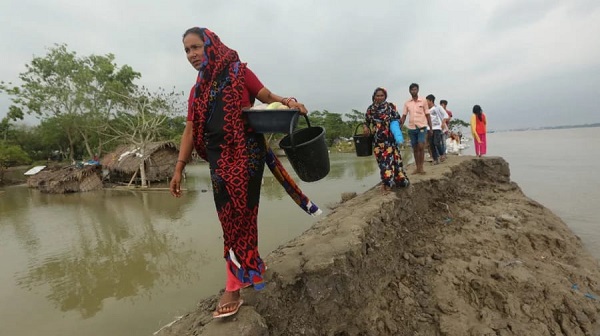Md Hasanur Rahman Tanzir – Both the number and severity of national disasters are increasing due to climate change. In the coming years, heat waves, desertification, lack of rain, cyclones, tidal waves, floods etc. disasters will cause the suffering of more than 39 million people in the poor countries of the world. Vulnerable populations in various countries have become more vulnerable to the effects of climate change in terms of their ability to survive. Women’s health risks are greater than at any other time.
Bangladesh is one of the countries at risk of climate change. Every year, salinity is reducing crop production, increasing the number of displaced people, and subsiding settlements due to rising sea levels. Various health risks are also increasing with the livelihood of the vulnerable population, especially women’s health risks are increasing .
Nijhum Dwip is an isolated township of Hatia Upazila. The population is about thirty thousand, half of whom are women and children. Fishing is their main livelihood. The size of the island is decreasing every year due to river erosion. Displacement, disease and malnutrition are their constant companions. Recurring floods, storms, tidal waves due to climate change have multiplied their risk.
Mosammat Deepa Khanam, the only midwife at Nijhum Dwip Union Health Family Welfare Centre, said, “3 to 15 women have to deliver here every day. Those between 15 and 18 years of age. Most of the men in the family go fishing in the deep sea. There is no opportunity for education. Child marriage is high here. Malnourished children are born here in malnourished bodies. I advise them to go to Hatia Upazila Sadar Hospital. Health care is me and a nanny here. The delivery table is also broken and there is no penguin seat, which is very important to save the life of the newborn.’
In response to the question of why women are more at risk due to climate change, the researcher, Dhaka University’s Disaster Management and Vulnerability Studies teacher Md. Shamsuddoha said, “The salinity of water in Gabura area of Shyamnagar in Satkhira district is the same as the salinity of sea water. Women’s health is affected, their menstrual cycles are disturbed. Women go down in the water and collect shrimp for several hours every day. Women with lack of menstrual management – Younger girls regularly take birth control pills without knowing the long-term effects. In pastoral and natural disaster prone areas, women do not have easy access to sanitary napkins, reproductive health care. They have to travel long distances for fresh water. Keep water for others in the family to drink by drinking salt water yourself or drinking less water. As a result, high blood pressure, skin diseases, pre-eclampsia and even miscarriages occur.” He further said, ‘ORS or packaged oral saline is not as effective in the south.’
‘When the men of the family leave the house to go fishing in the deep sea, the women stay behind with the whole family; The family’s small children, adolescent girls, the elderly have to take responsibility.” These words were spoken by Abul Hasan, head of Climate Change Department of Coast Foundation. A diver is waking up in the sea. Fish not available. The man has to go deeper into the sea. Thinking about security, the teenage girl has to get married. The teenage boy has to be given to bricklaying or some other work. Sometimes the whole family has to work in the brick kiln to pay the fishermen’s wages. Sometimes one has to stand in salt water for hours to collect fish fry. These incidents are of the women of fishermen’s families in Cox’s Bazar.
Meteorologist Dr. Bangladesh Meteorological Department. Kalam Mallick said, ‘Another impact of climate change is the gradual increase in heat waves. Here too women are more vulnerable because of their clothing. Because women cover their bodies with many different clothes. As a result, excessive heat increases women’s risk of heat stroke. Again, during this heat wave, a lot of time is spent in the kitchen, where there is no adequate ventilation in addition to smoke and heat. As a result, women are suffering from asthma and shortness of breath. Apart from this, the risk of death of women in any natural disaster due to clothing is very high.
Jannatul Mawa, executive director of Satkhira district development organization ‘Bindu’, said that 39.9, 41 and 40 percent women and girls are suffering from reproductive health problems in Asashuni, Kaliganj and Shyamnagar upazilas of Satkhira district respectively. Apart from this, most of the women are suffering from various complications related to urine infection and reproductive health due to drinking salty water or drinking less water. Due to these complications in the reproductive health of adolescent girls, child marriage is on the rise in these areas and they are facing various physical problems due to childbearing at a young age.
According to the World Health Organization (WHO), experts fear that more than 250,000 people may die every year in the world from 2030 due to malnutrition, malaria, diarrhea and temperature-related physical complications. “Extreme weather has become a serious health issue,” said Martin Edlund, CEO of the non-profit organization Malaria No More. heat stroke due to heatstroke; That is, temperature-related physical complications are increasing. Women’s reproductive health is at risk. These are just a few examples of how climate change is negatively impacting public health.
According to number 13 of the Sustainable Development Goals or SDGs, the biggest obstacle to taking urgent measures to combat climate change and its impacts is the international community’s drift away from its commitments. Only 85 countries have so far adopted national disaster management plans. Developed countries have not reduced their investment in fossil fuels either. As a result, no effective measures have yet been taken to reduce carbon emissions and prevent global temperature rise.




















